A 6 Step Guide To Stage Your Home For Sale Like A Professional (A Real Life Case Study)
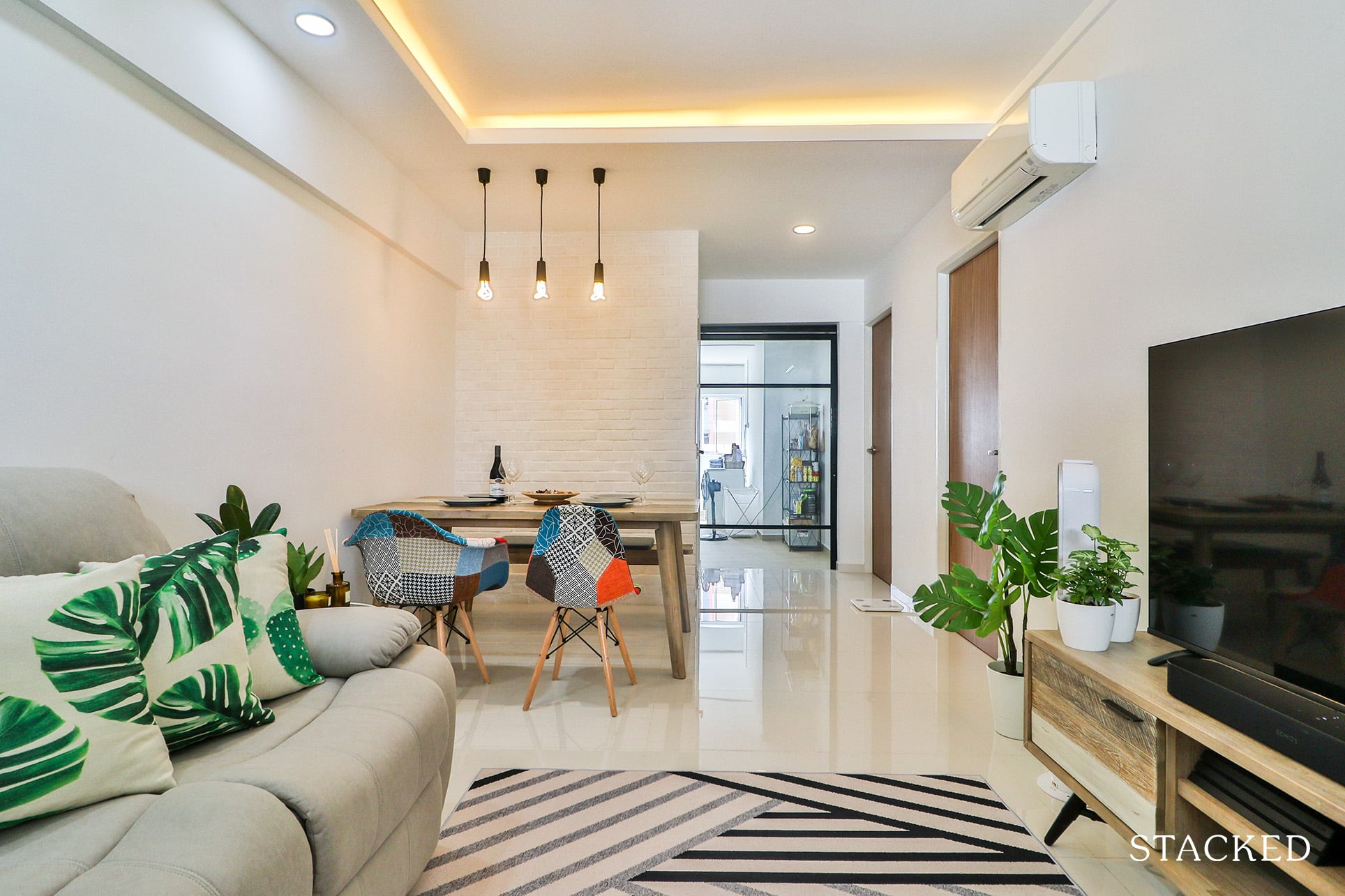
Get The Property Insights Serious Buyers Read First: Join 50,000+ readers who rely on our weekly breakdowns of Singapore’s property market.
Daron is a multi-award-winning property consultant known for his dedication to service and unwavering passion for real estate. Embracing the ethos of giving back, he approaches each client interaction as a trusted friend and attentive listener, ensuring a personalised and seamless experience. To date, he has assisted over 400 clients with their real estate transactions. With a background in creating efficient structures and a commitment to continuous improvement, Daron consistently delivers optimal results for his clients, reflected in his impressive track record of success. In his free time, he dedicates himself to serving his church community at Kingdomcity, further exemplifying his commitment to making a positive impact both professionally and personally.
It’s a Saturday night.
You’re about to go on a first date and have spent hours looking for the perfect outfit.
You get your hair styled and slather on some cologne (or perfume, for the ladies).
You even spend the time to ensure that the perfect date is planned out.
It’s a lot of effort for someone you’ve never met, so why do you do it?
Well, it’s simple – it’s all about making a good first impression.
There’s an old rule of thumb that says you have seven seconds to make a good first impression. While I doubt that it’s seven actual seconds (who counts these?) the general idea is definitely true.
Can you imagine going on a first date and meeting a shabbily dressed person? He/she smells like they have not bathed in a few days, and their hair is a mess.
Would you have a good impression?
Perhaps so, if you’ve inhaled an entire bottle of whisky beforehand and can’t tell the difference between Donald Trump and Chris Hemsworth.
Or if you’re someone like Elon Musk with billions of dollars in the bank.
But for most ordinary folk it would be hard to shake off such a first impression.
This is why I’m always shocked when I see the condition of some of the homes that people are willing to put up for sale.
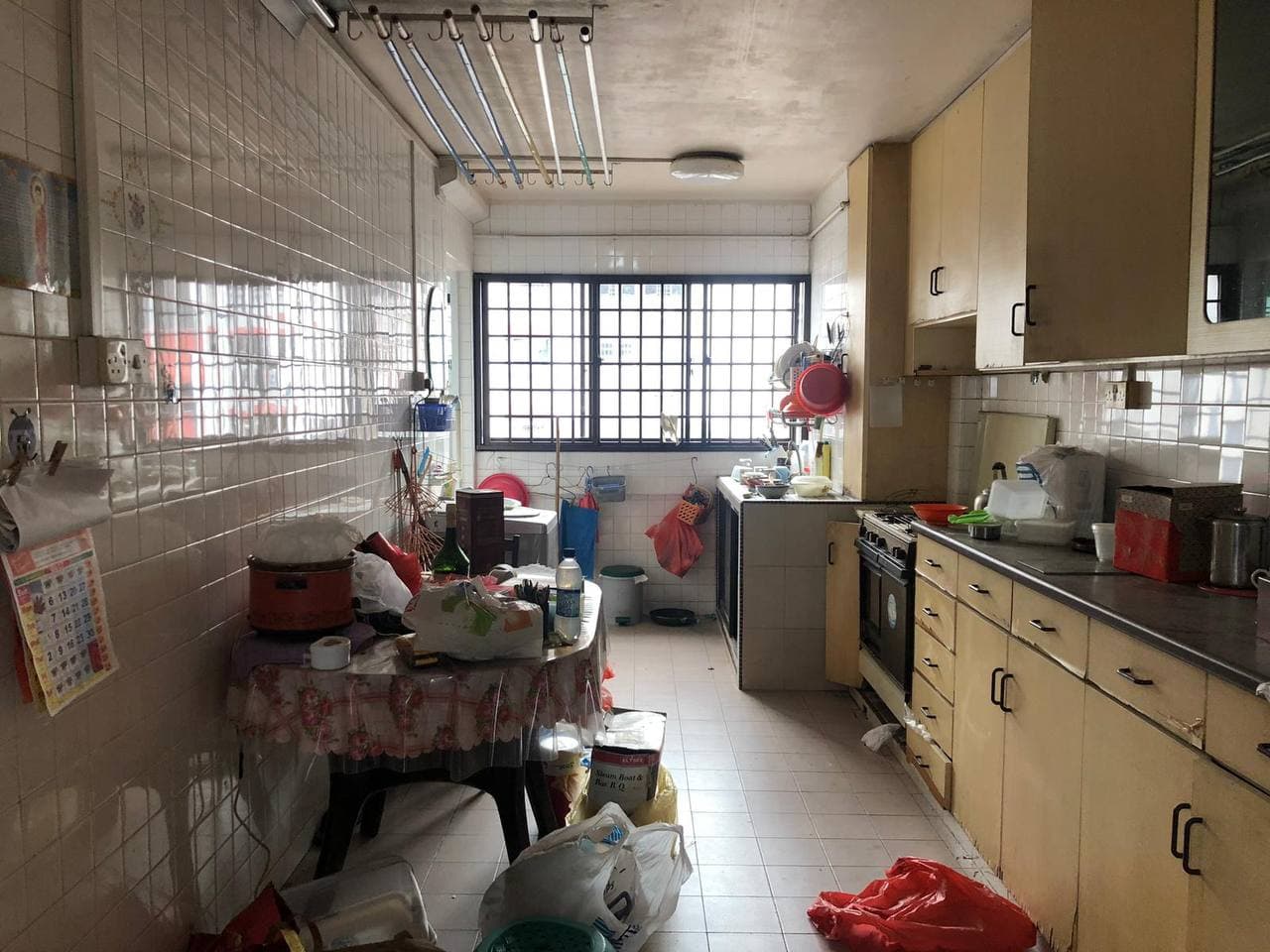
When it comes to property viewings, first impressions can make or break a deal. If the buyers aren’t impressed the first time around, there’s a good chance the property sale dies there and then.
So unless you are living in a vacuum and the buyer has no other option, it’s often hard to visualise living in a space as cluttered such as the above.
Most buyers would not be able to spot a gem in the rough (even if it is apparent to you, the seller).
As proof of this, I recently used some simple staging methods to improve the appearance of a unit; and in less than a month, sold it for $75,000 above the previous offer. Here’s how I did it:
How much of a difference can staging make?
The following images are from a condo in D15, that was marketed this year. Initially, the listing saw only one offer between June to November, for $1.7 million.
After the owner moved out, however, I had more opportunities to give it a makeover. I and my team started staging the unit on the 1st of November; and within three weeks, the unit was sold for $1.775 million.
Here’s how the unit looked before and after staging:
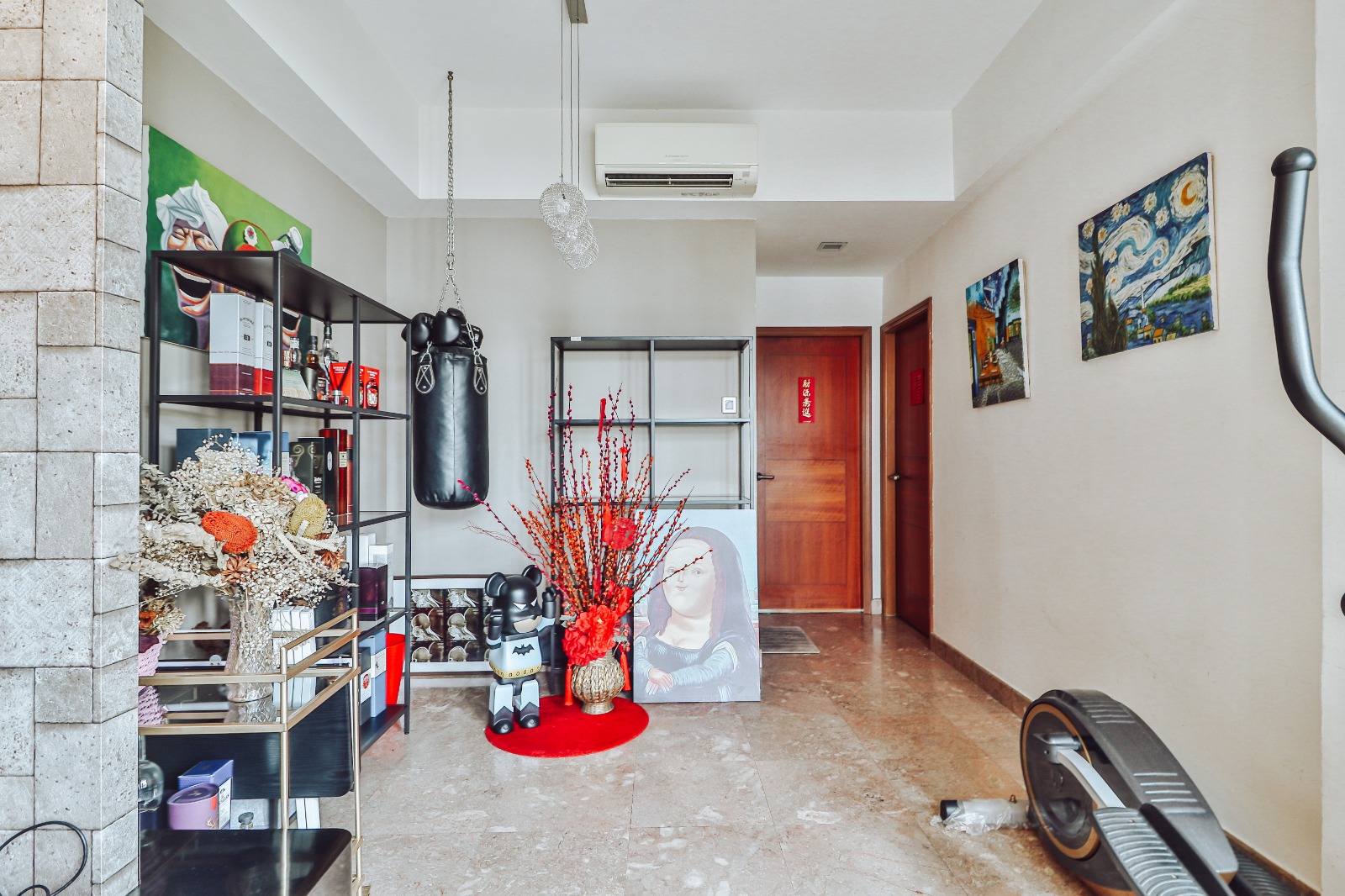
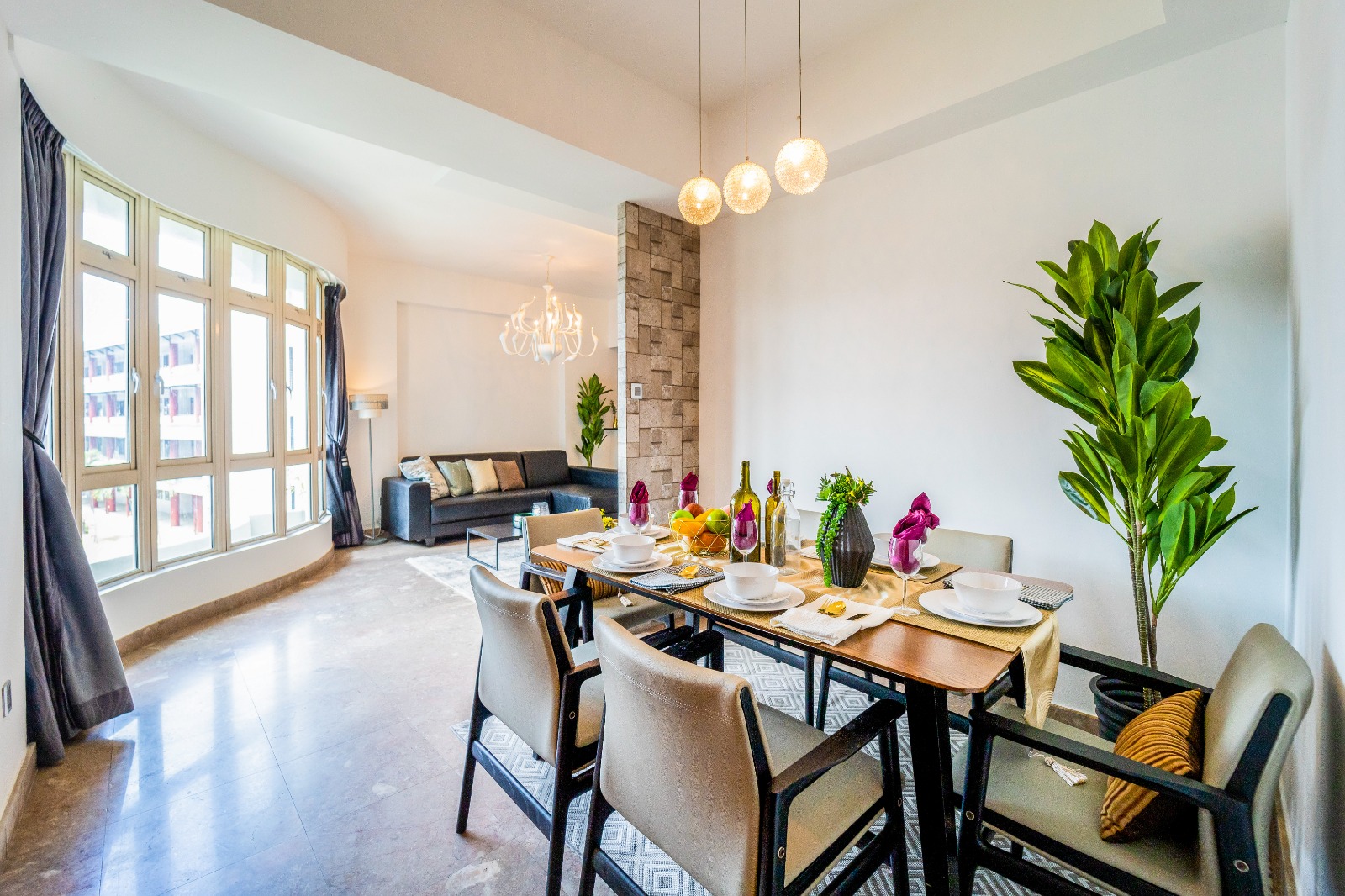
The owner originally used the dining room as just a storage area. One of the bedrooms also had a full walk-in closet, which took up a good amount of space.
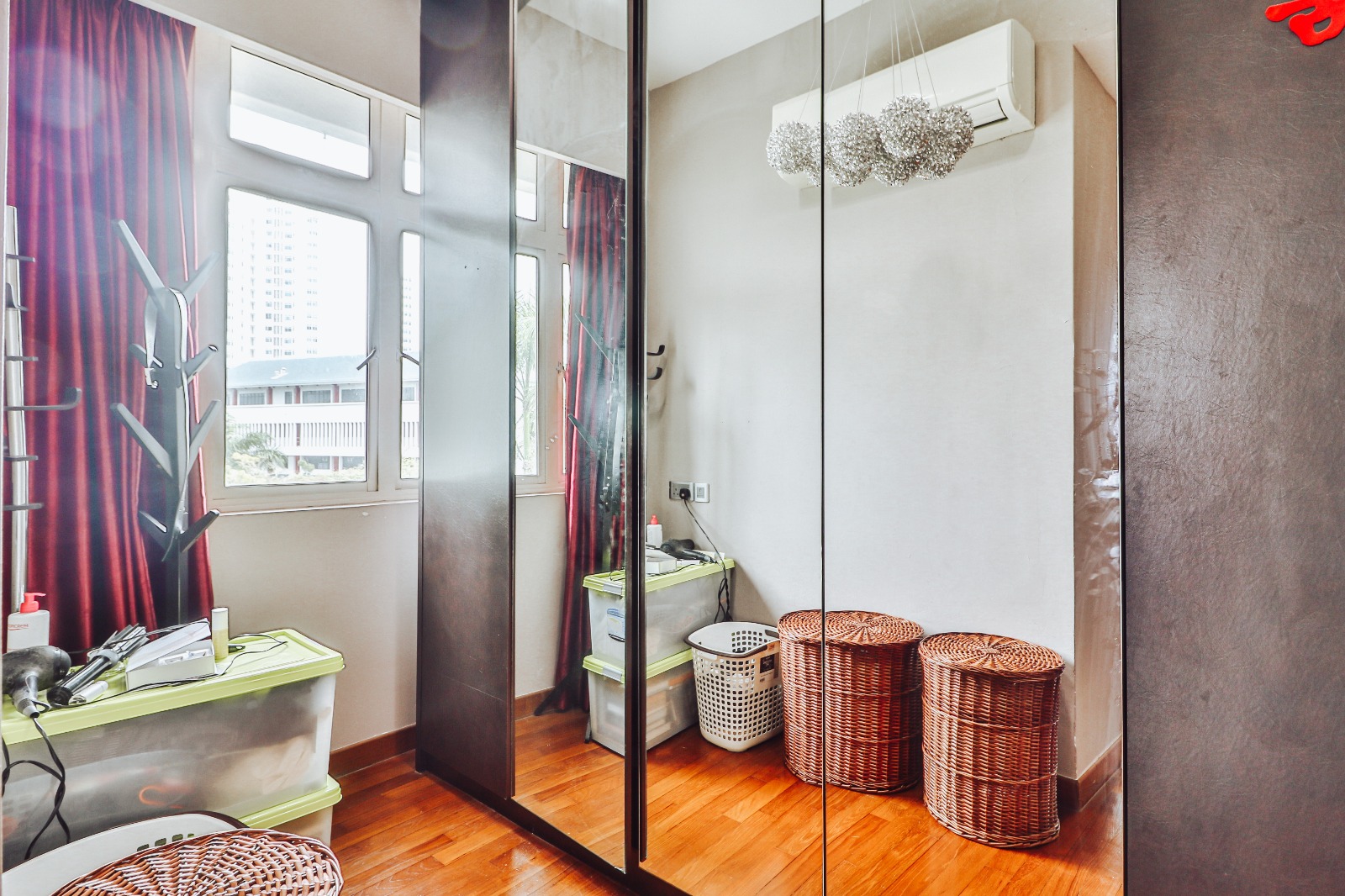
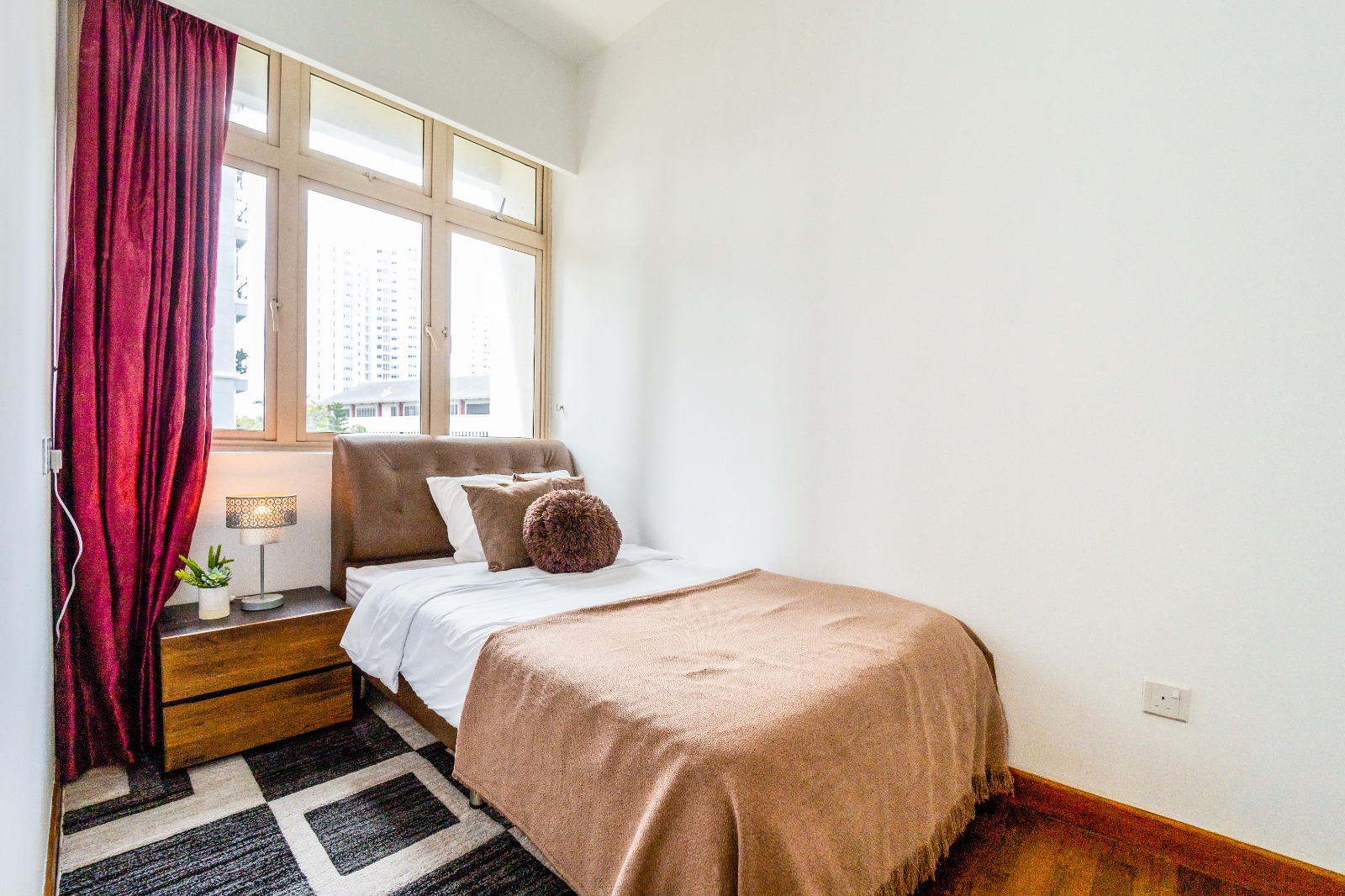
Once the owner had moved out, we restored the dining area with a proper dining set and staged the bedroom to show it could fit a comfortably sized bed.
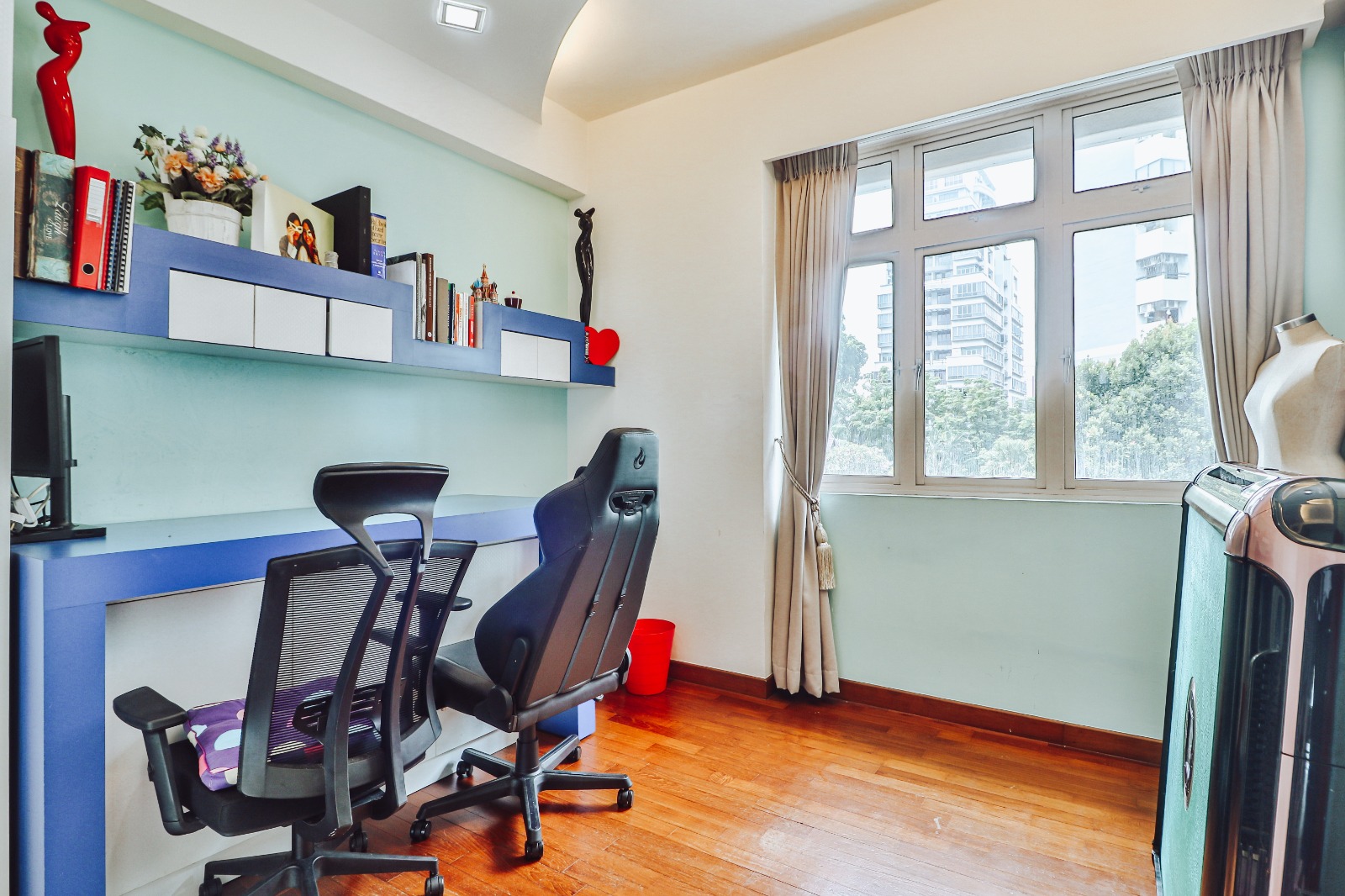
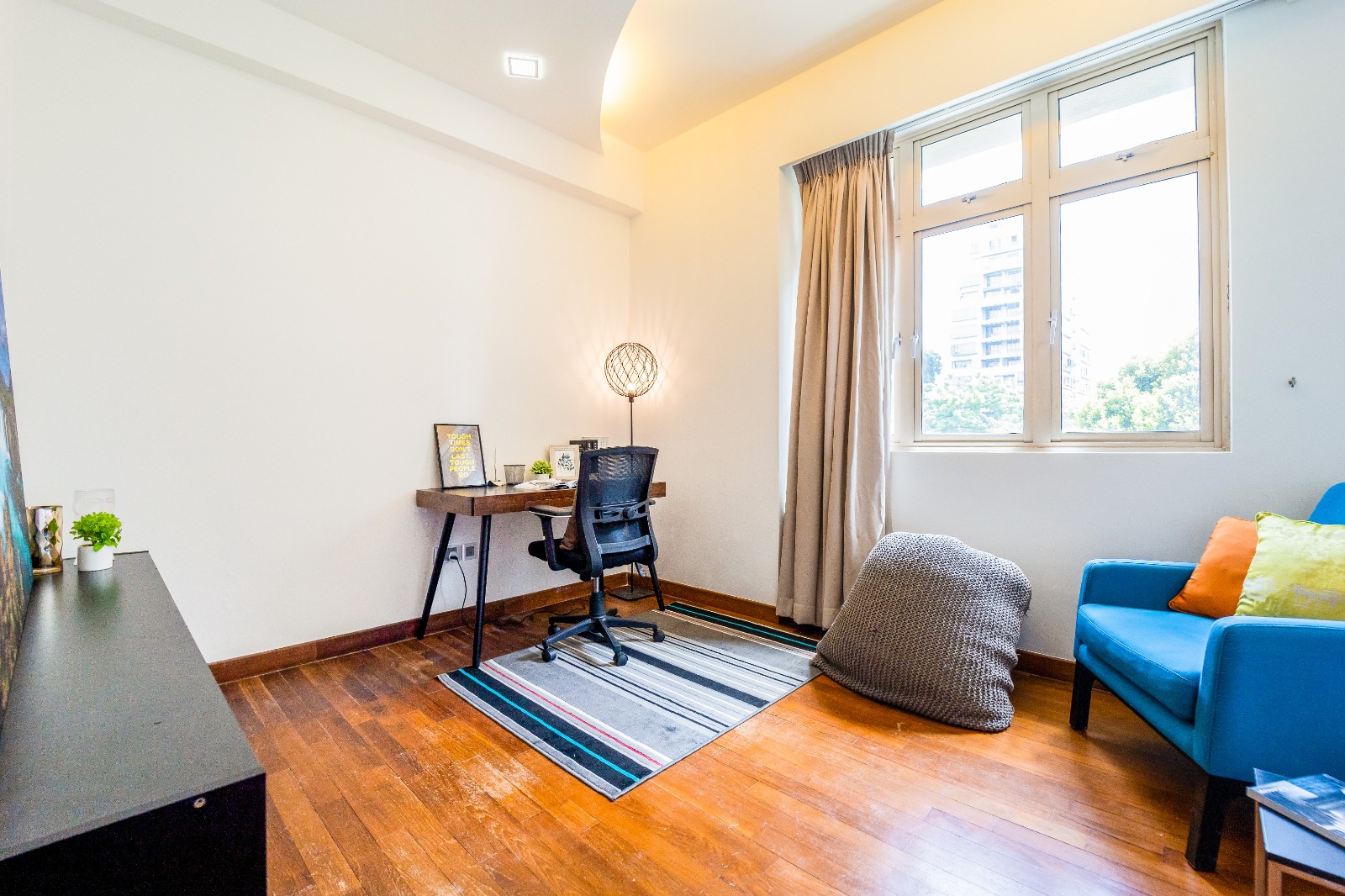
The main idea is to showcase what the rooms are fully capable of – they don’t need to match what they’re actually used for at the moment. For example, you could take a nook that’s being used to hold old electronics, clear it out, and turn it into a study with the addition of a desk.
So how can you stage your own home this way?
It doesn’t require significant expense, just a willingness to pack and shift things around (but hey, if you’re selling soon, you probably need to pack anyway, right?)
Here’s my step-by-step guide on how to stage your home to sell like a professional:
- Focus on making a good initial impression
- Staging starts from the point of contact
- Clean and declutter the property
- Depersonalise the unit for viewers
- Highlight available storage
- Use inexpensive furnishings for impact
1. Focus on making a good initial impression
Good home staging means the client feels good about the space, from the moment they walk through the door. If the client’s very first impression is one of discomfort, everything you tell them after that may not register.
You can point out nearby MRT stations, good appreciation, etc. but it will be overridden by their initial gut response of “I can’t live here!”
Property developers know this quite well, that’s why they’re willing to splurge on top designers for their show flat.
For DIY home staging, try getting friends who seldom come over, to walk in for the first time. Get their frank initial impressions, to see if your staging works.
2. Staging starts from the point of contact
Home staging means making the entire viewing process a pleasant experience. It’s not confined to just visuals within the unit.
This means you also need to smoothen and plan processes like:
- First conversations with prospective buyers (how will you introduce the rooms? In which sequence?)
- Delivering instructions on how to get to the unit
- Walking the buyer from the entrance or lobby to the unit (especially if you need to explain security systems)
- Putting together a good set of photographs, in case you need to send any via text, email, etc.
You can’t always control when prospective buyers will visit; but if given the chance to suggest the time, pick a quieter period, or a time when the view looks most impressive.
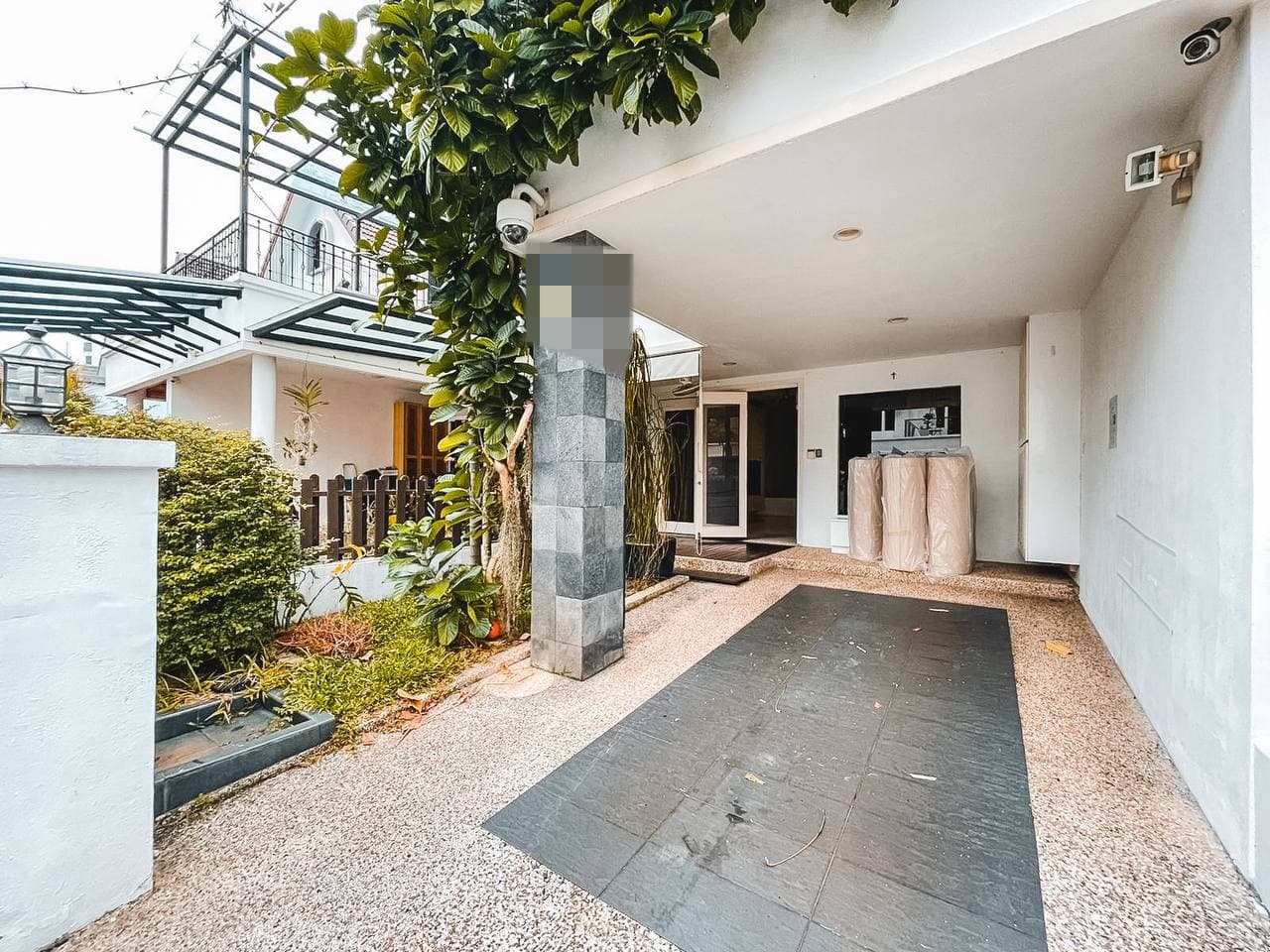
Homeowner StoriesFrom An EC To A 999-Year Landed Home: How I Helped My Clients Achieve Their Dream Home
by Daron Ang3. Clean and declutter the property
Decluttering is the number one priority when setting out the rooms. One of the most common complaints I hear from viewers is “I don’t like the mess”.
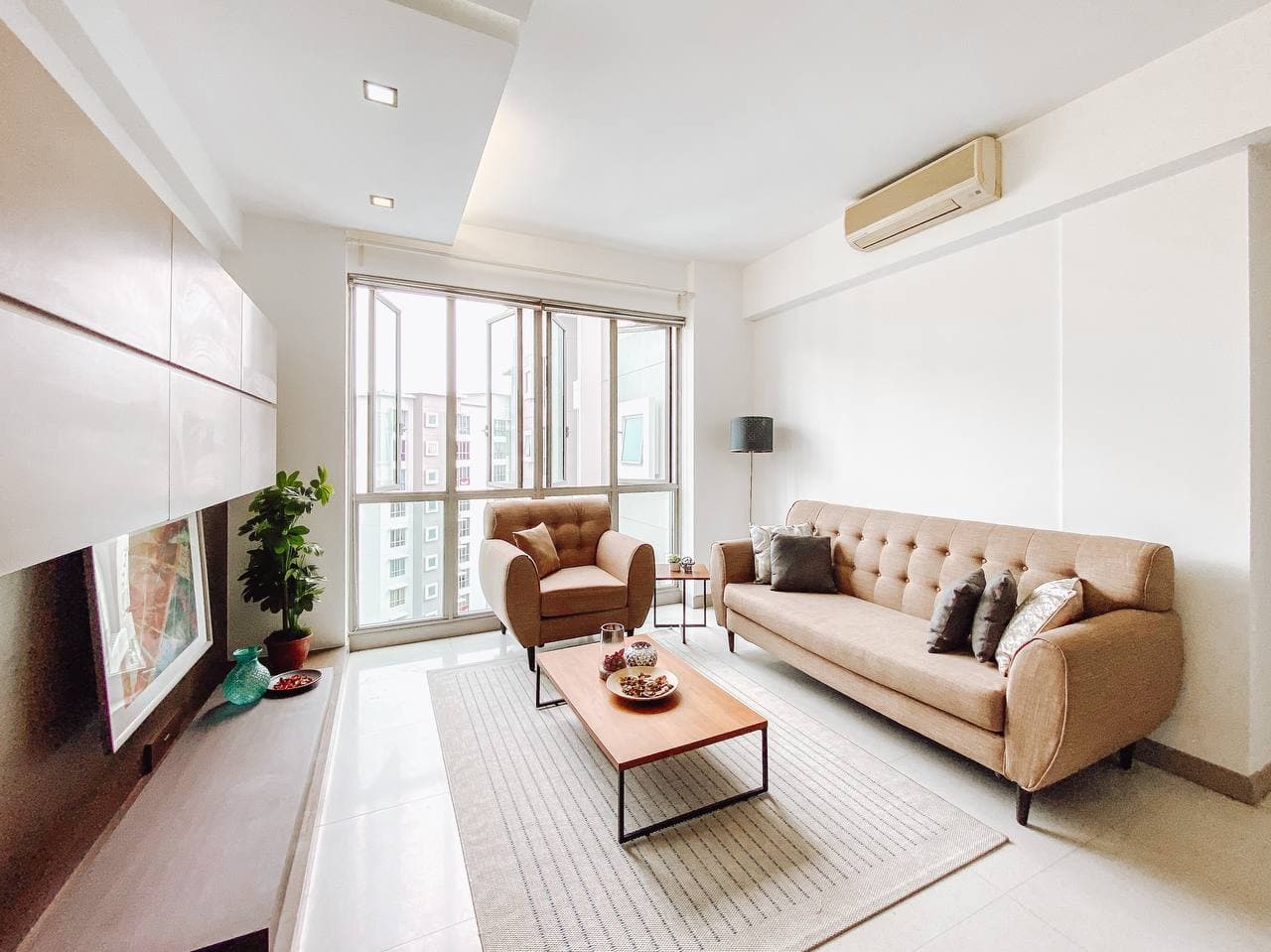
When you declutter, you make the unit look as spacious as it can be. Many a living room would look airier, if you just moved away the non-functioning massage chair, piled up newspapers and mail, knick-knacks on top of TVs and pianos, etc.
Cleaning the property beforehand is also a must. When home viewers spot dead cockroaches or feel grimy floors, the immediate impression is that the property is not well cared for. Note that “cleaning” is just about the smell as well as visual – use light air fresheners, if you have to chase out lingering smells like cigarette smoke.
4. Depersonalise the unit for viewers
This is part of decluttering. In general, you want to stage the unit so that prospective buyers can visualise it as their own home.
You will detract from this if you have too many reminders that someone else lives there (e.g., too many family photographs, children’s drawings on the fridge, names on doors).
This isn’t to say you need to remove every sign of homeliness; you also don’t want to give the impression of a cold and generic unit (the main problem with show flats). But you may want to pack away the most highly personalised items, like family portraits or children’s school awards.
5. Use inexpensive furnishings for impact
You don’t need to buy designer furniture, or other high-end items, to stage a unit.
Let me show you how to do it and the items you need. (Special thanks to Lazada for the items!)
What you want to look out for are some inexpensive (but not cheap looking!) items, which can add a lot of colour and impact to the rooms:
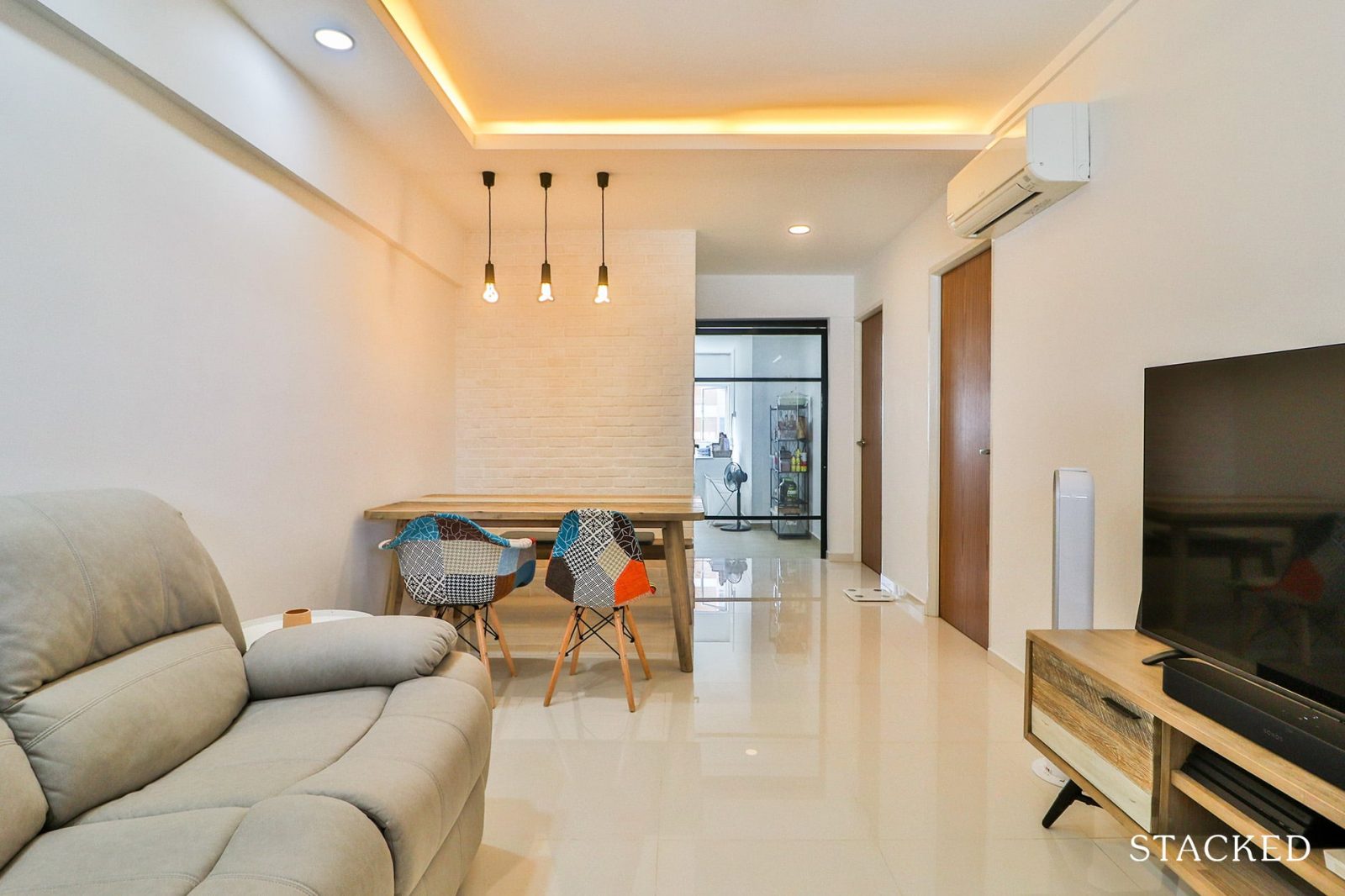
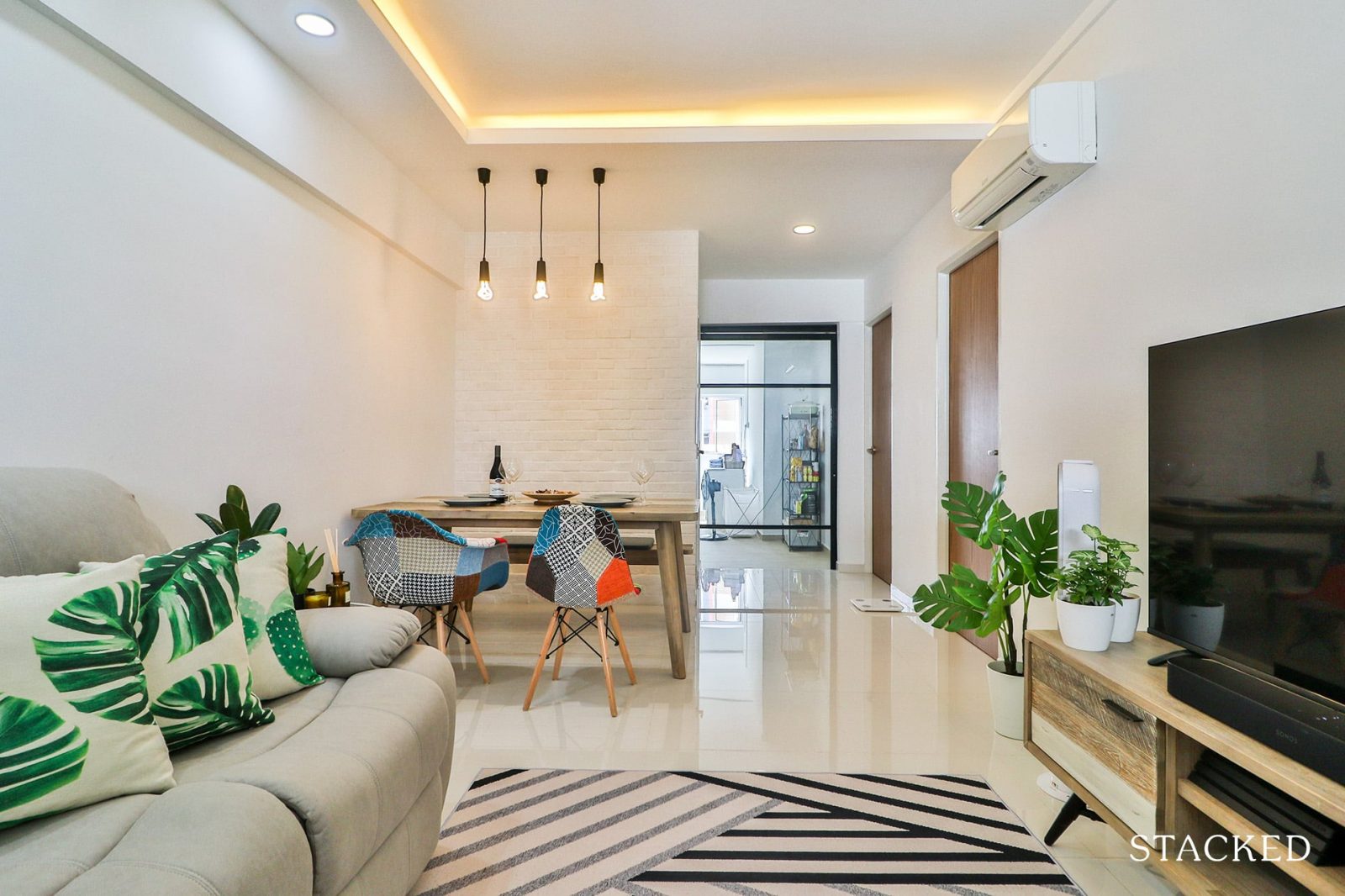
Note that the before images are already decluttered and tidied up.
Some of my favourite items to use for the staging of a living room are cushions (preferably bright and cheery ones), plants, and candles/fragrances.
Of course, these will contribute towards a pleasant smell through the home too.

I do like to use both reed diffusers and candles. Candles just for the look, and the diffusers for the smell. Small plotted plants for the coffee table also goes a long way in adding more variety and greenery to the overall look.
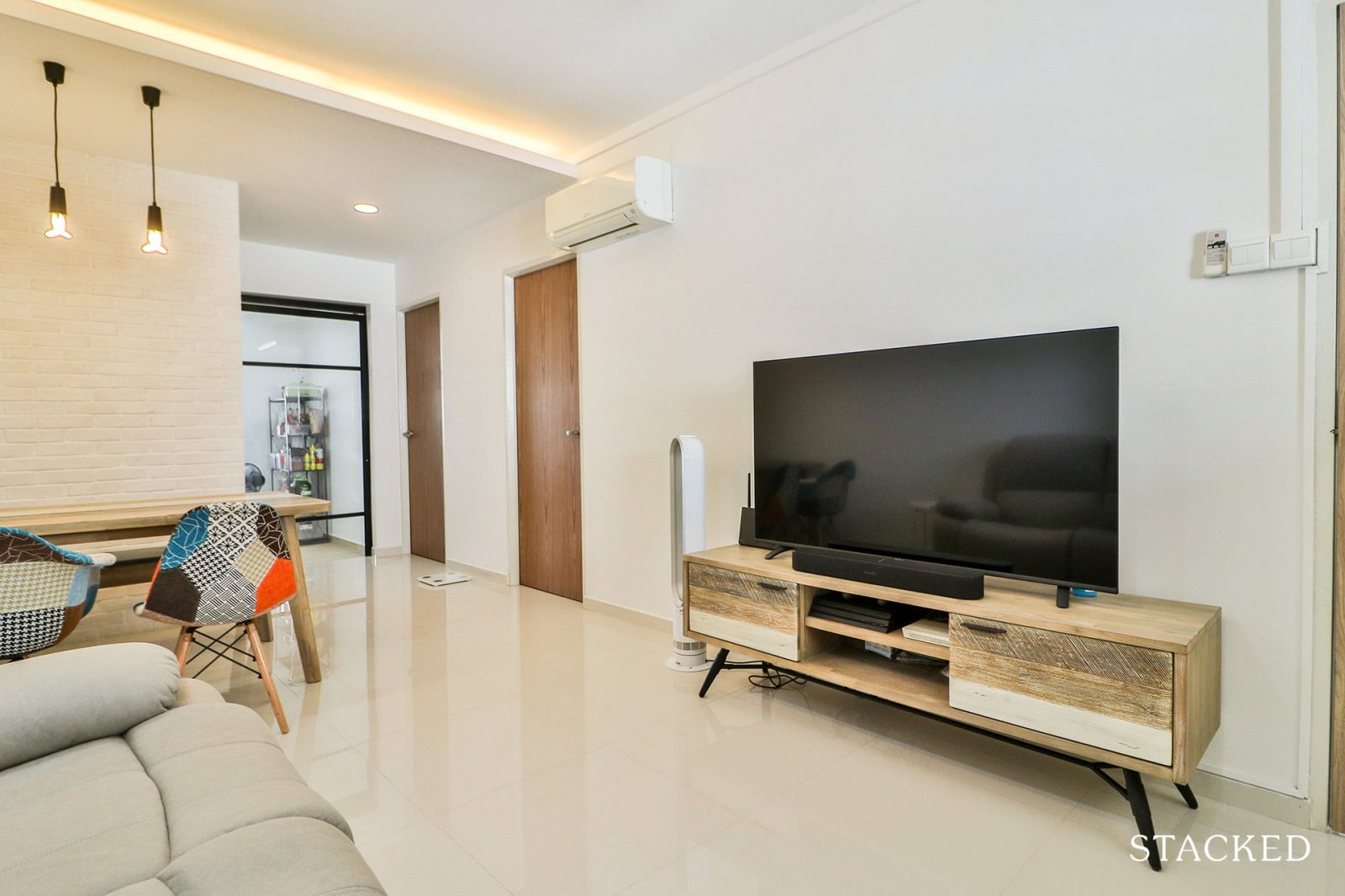
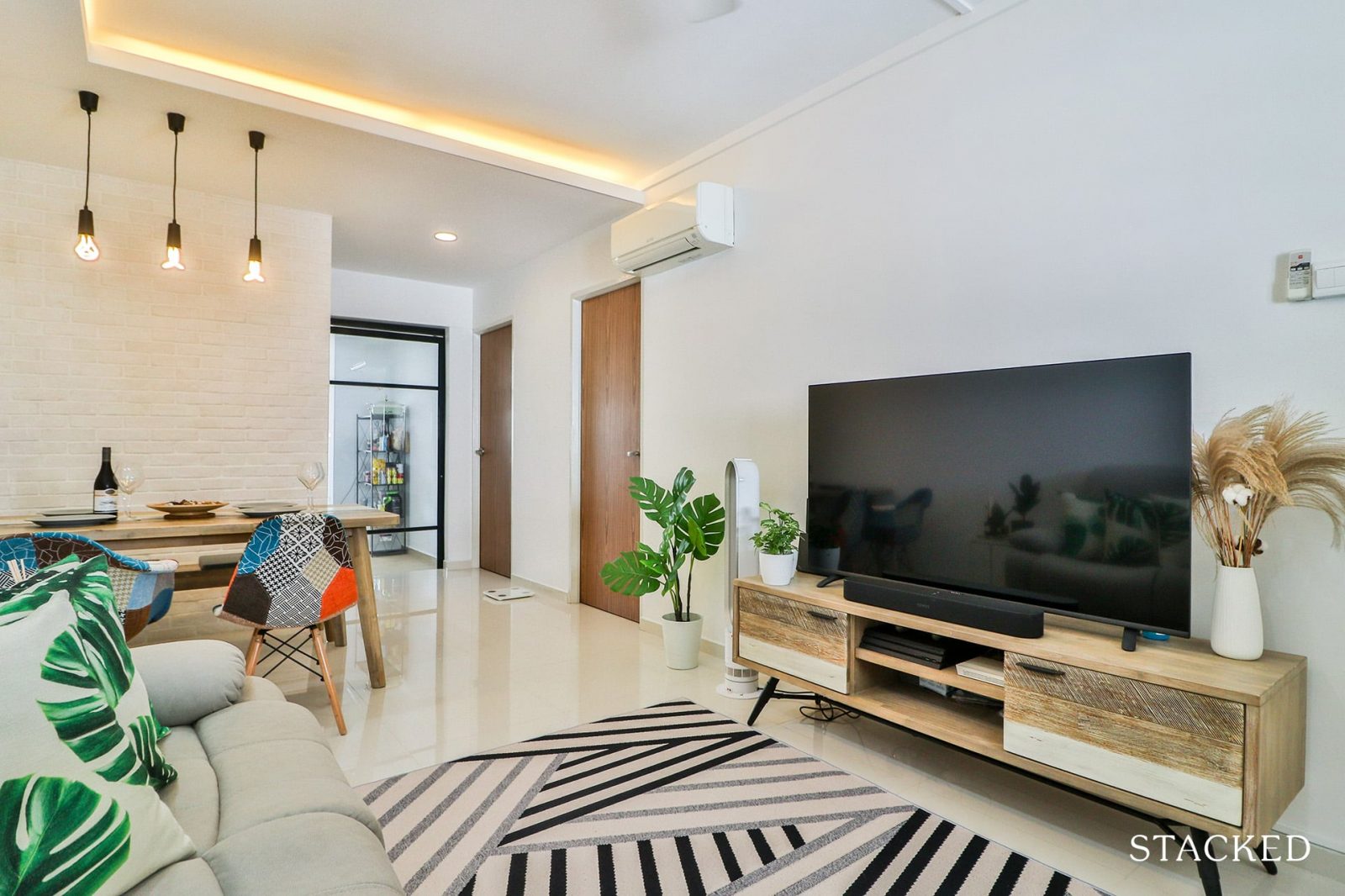
I’m a big fan of plants (as you can probably tell by the cushion designs), and here are some of my other favourites that I like to add when I stage a home. I do like the Schefflera Green as the small leaves really add more texture and variation, as with the Syngonium Green for the different shades of green.
Likewise for the dining area. It’s simply furnished (you can be more elaborate if you’d like), but just a straightforward set-up with plates, a wine bottle, and wine glasses.
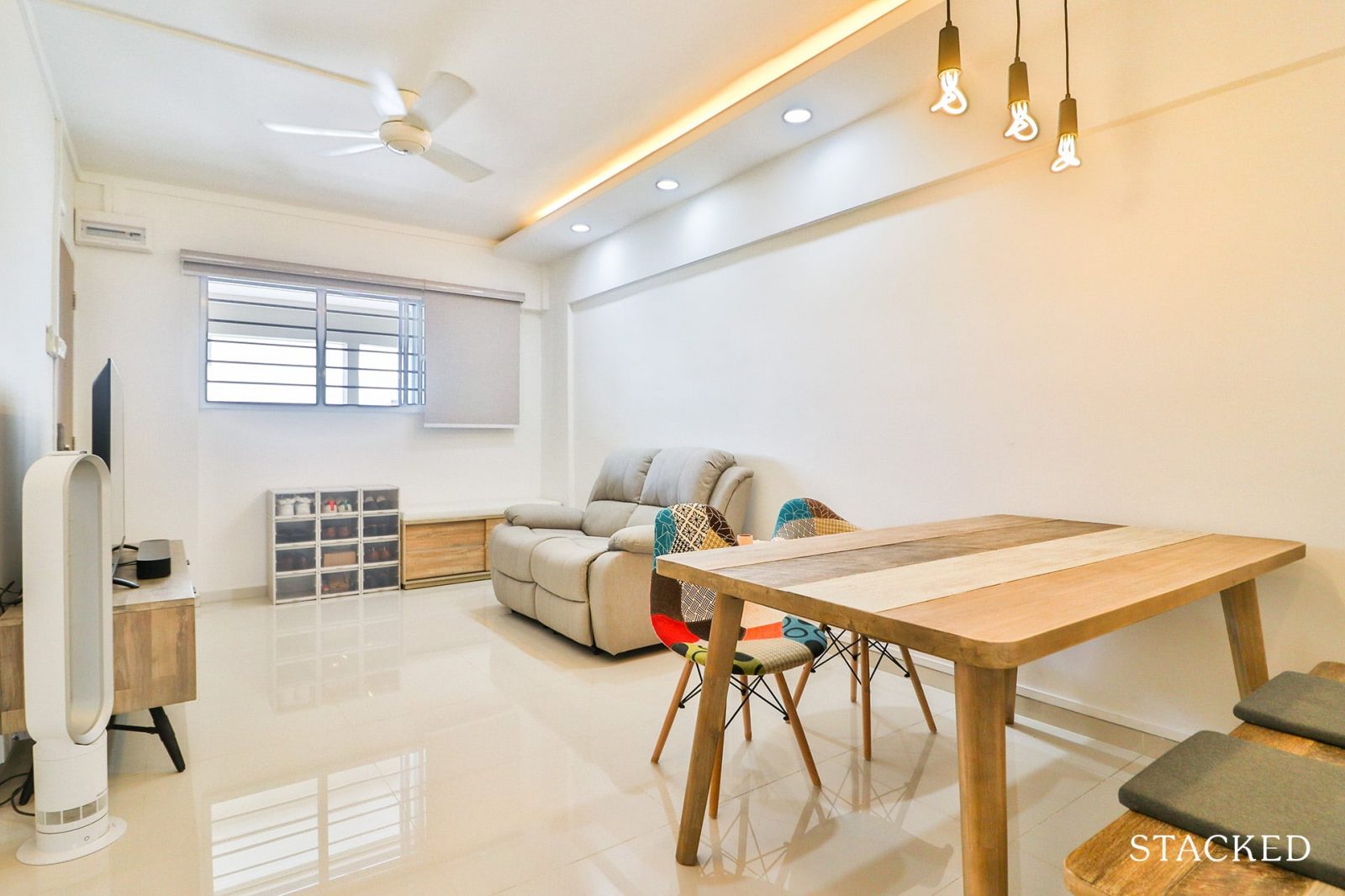
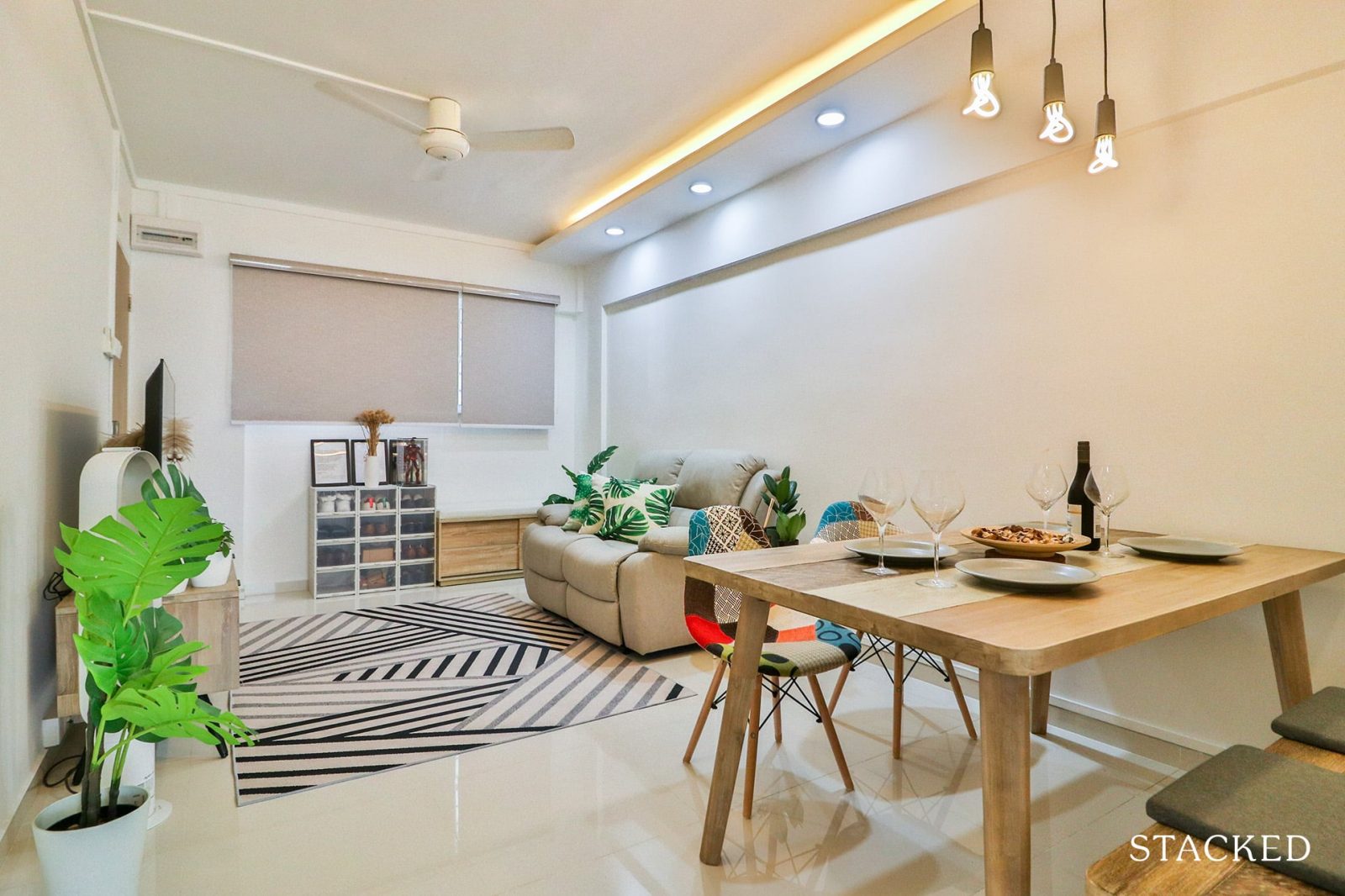
Another visual “trick” I like to use is the addition of carpets. Sometimes a space might look too bare, and adding a printed rug can help to add more visual identity to a space.
Personally, the Nordic designs are my go-to as these are usually the easiest to match.
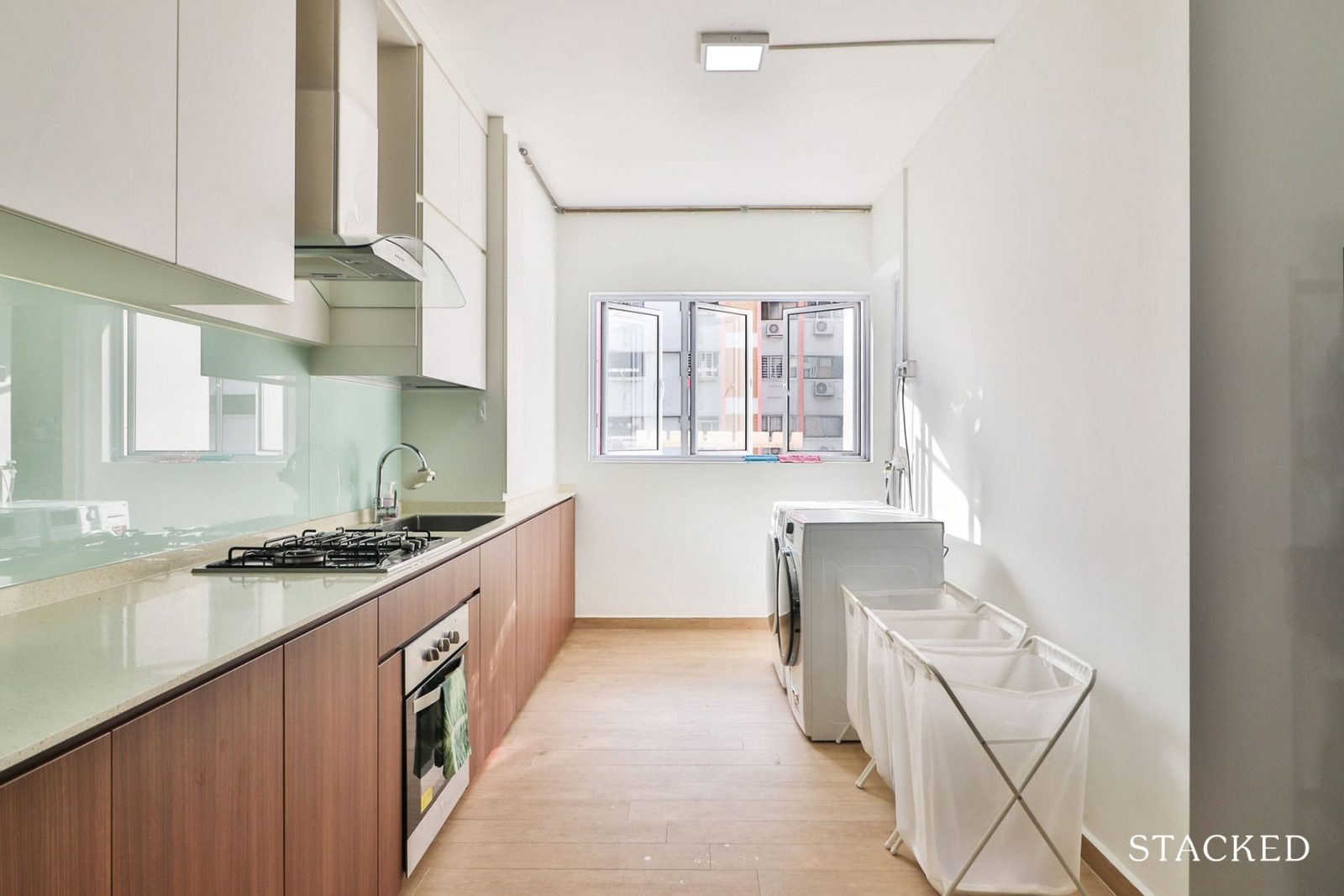
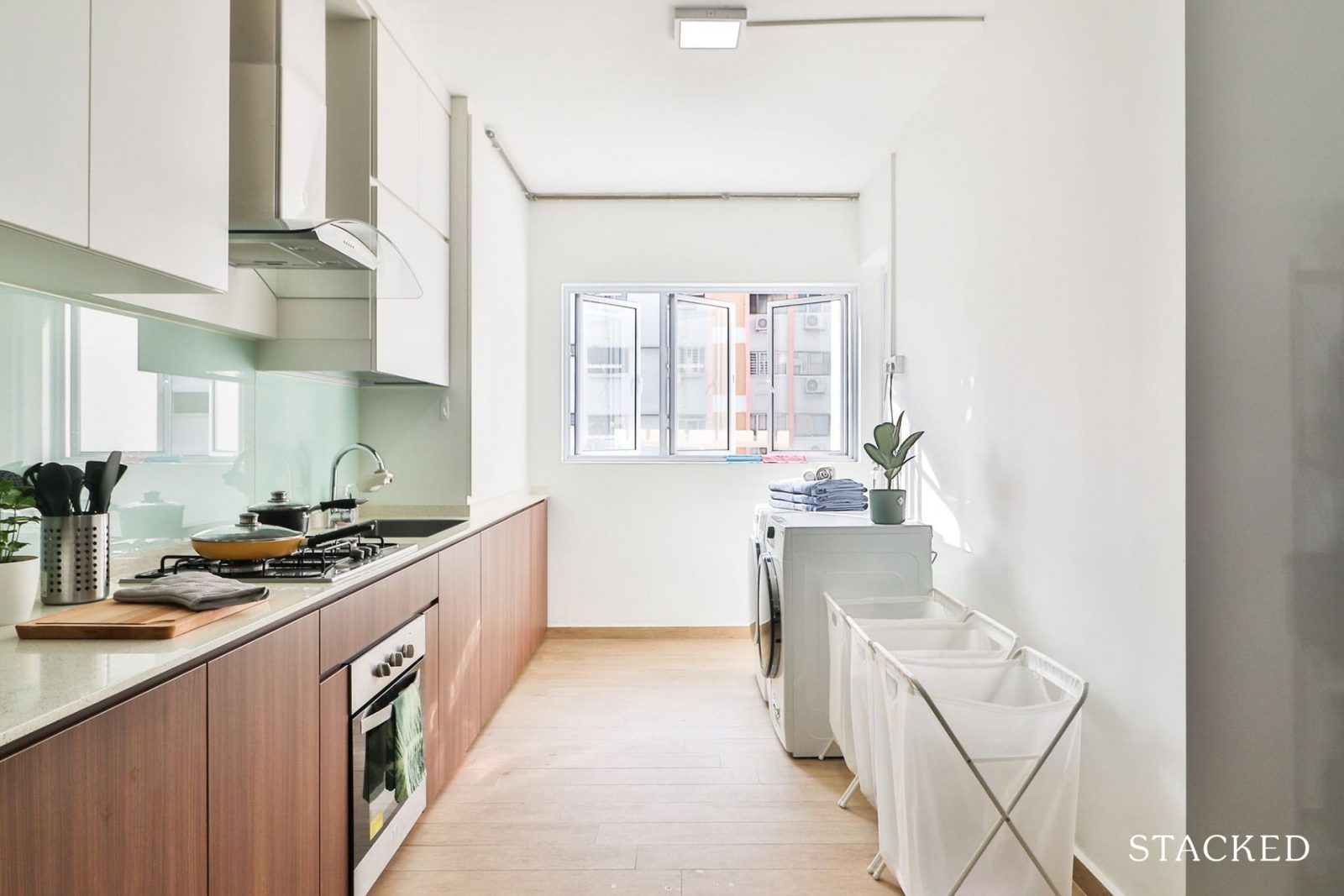
Many people tend to ignore the kitchen, but like the rest of the additions, it really doesn’t require a lot to spruce it up.
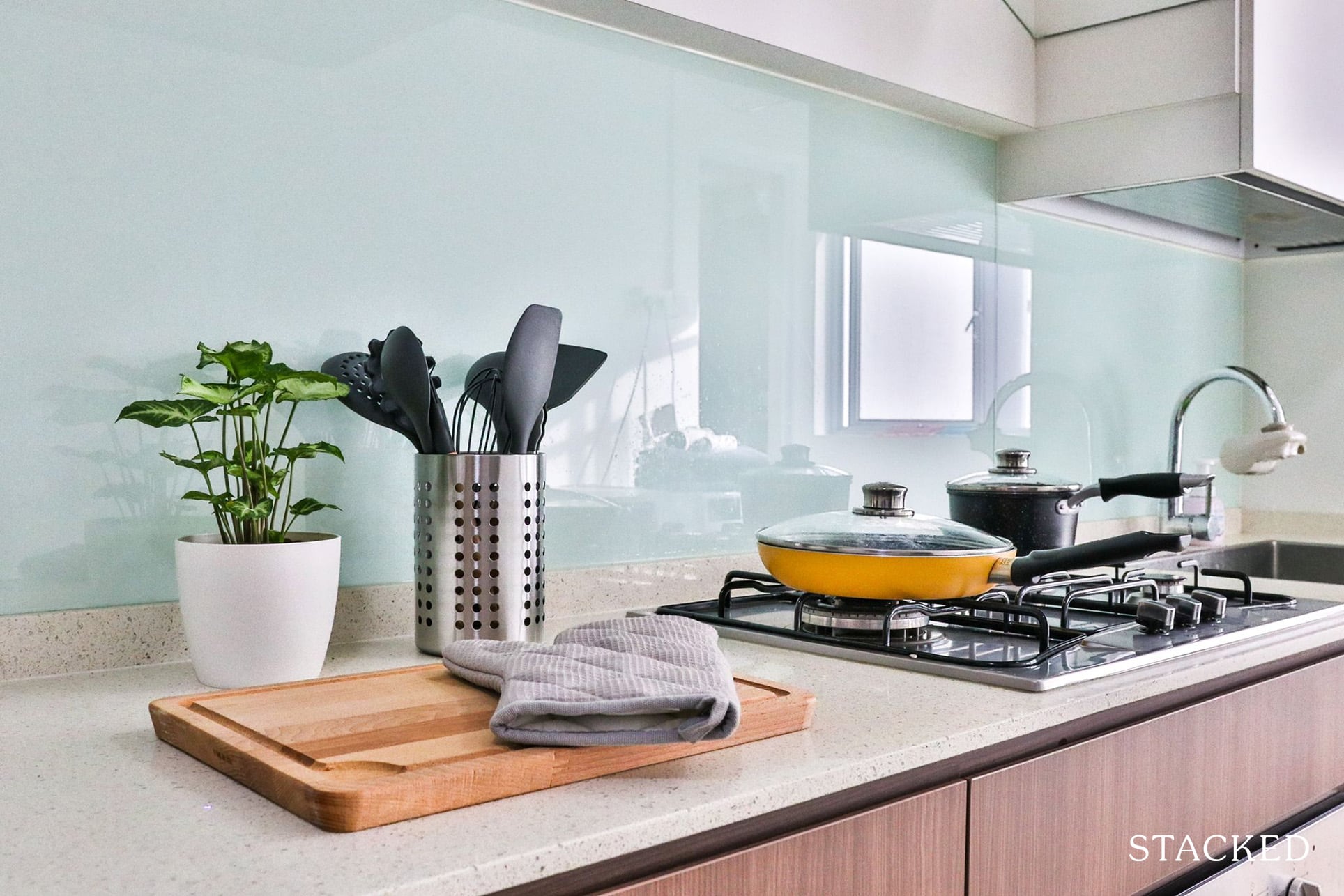
As with the dining area, some kitchen utensils will do the trick to liven up the space.
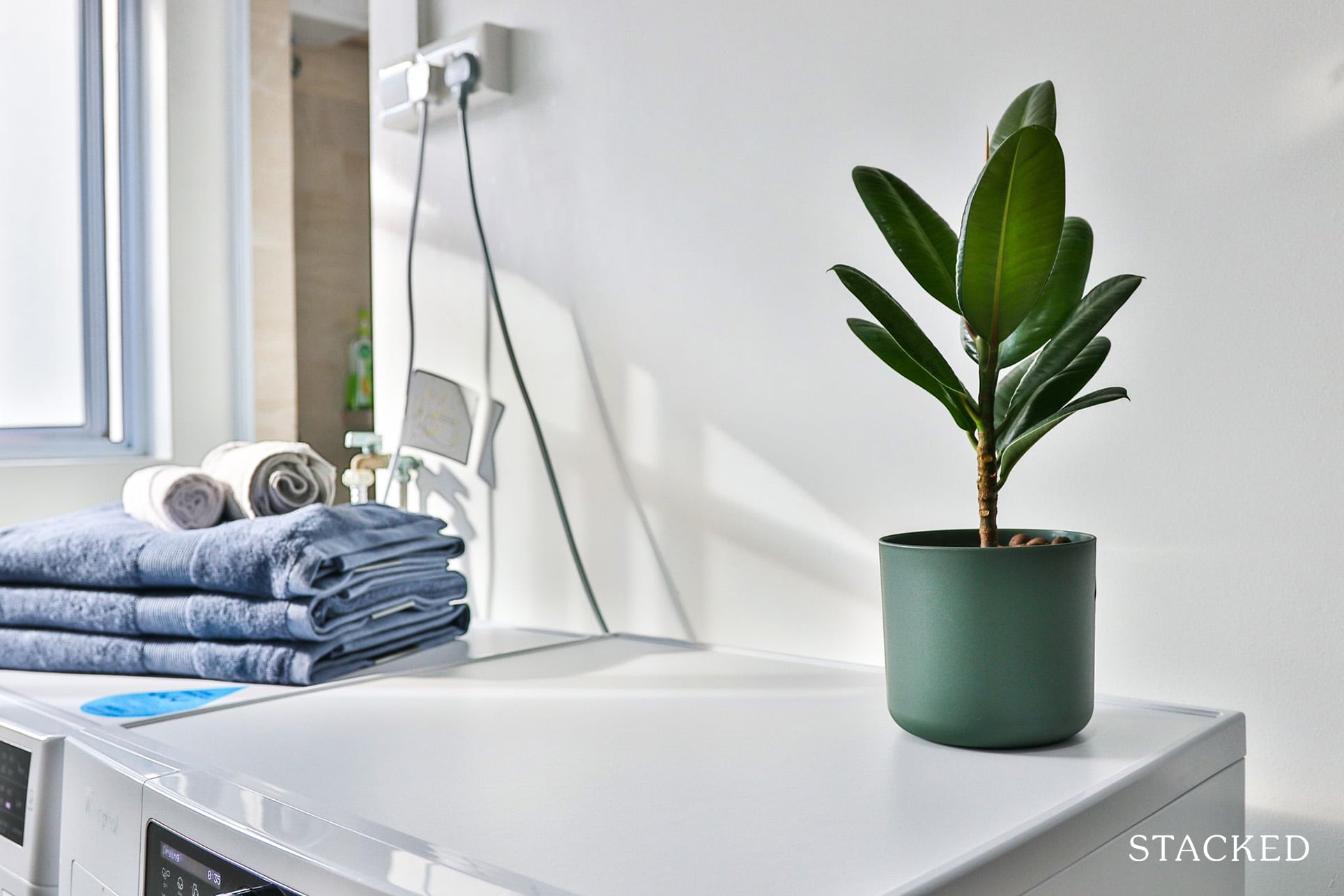
Even a plant and towel set above the washing machine can make the space look that bit more homely.
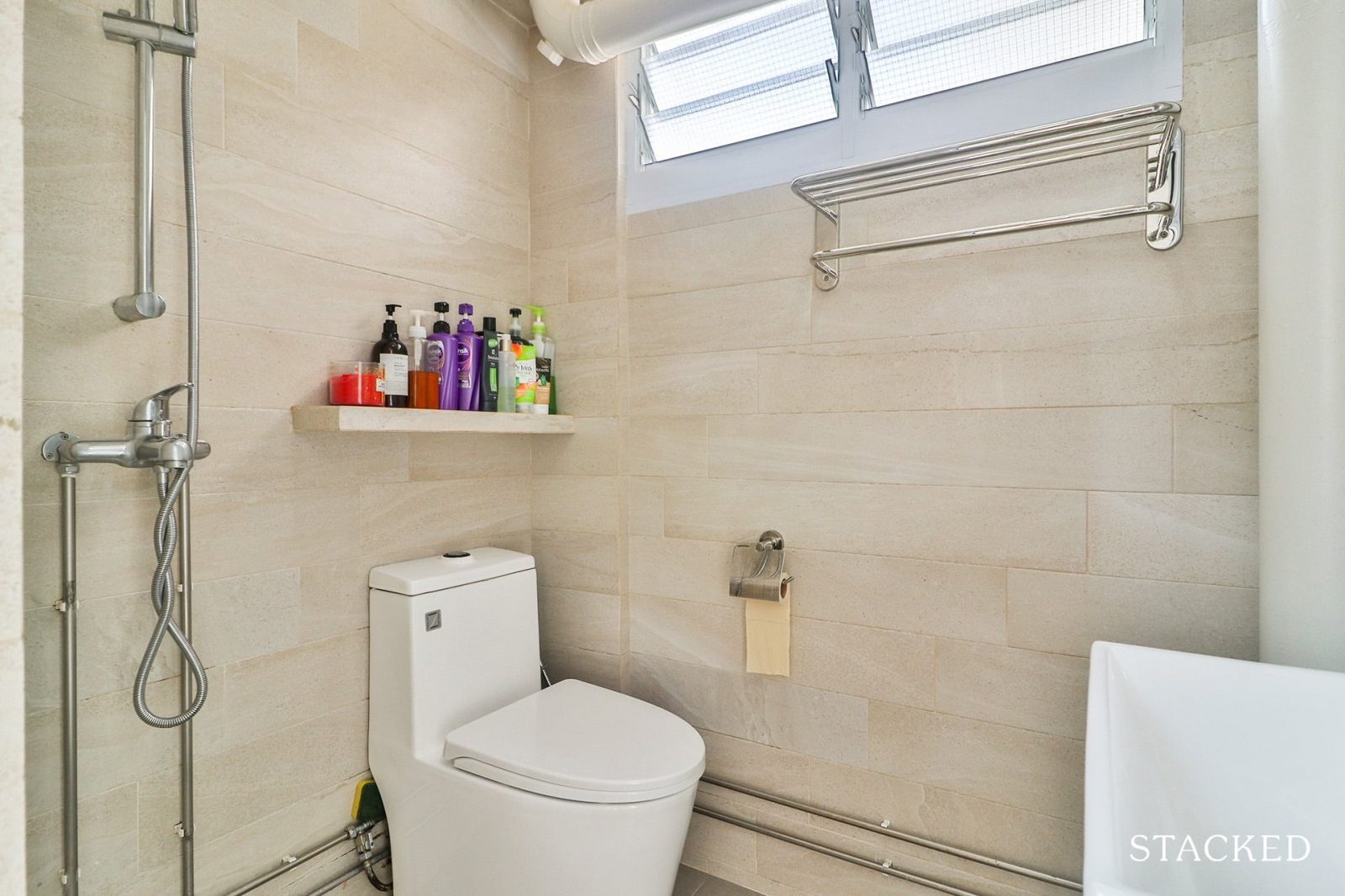
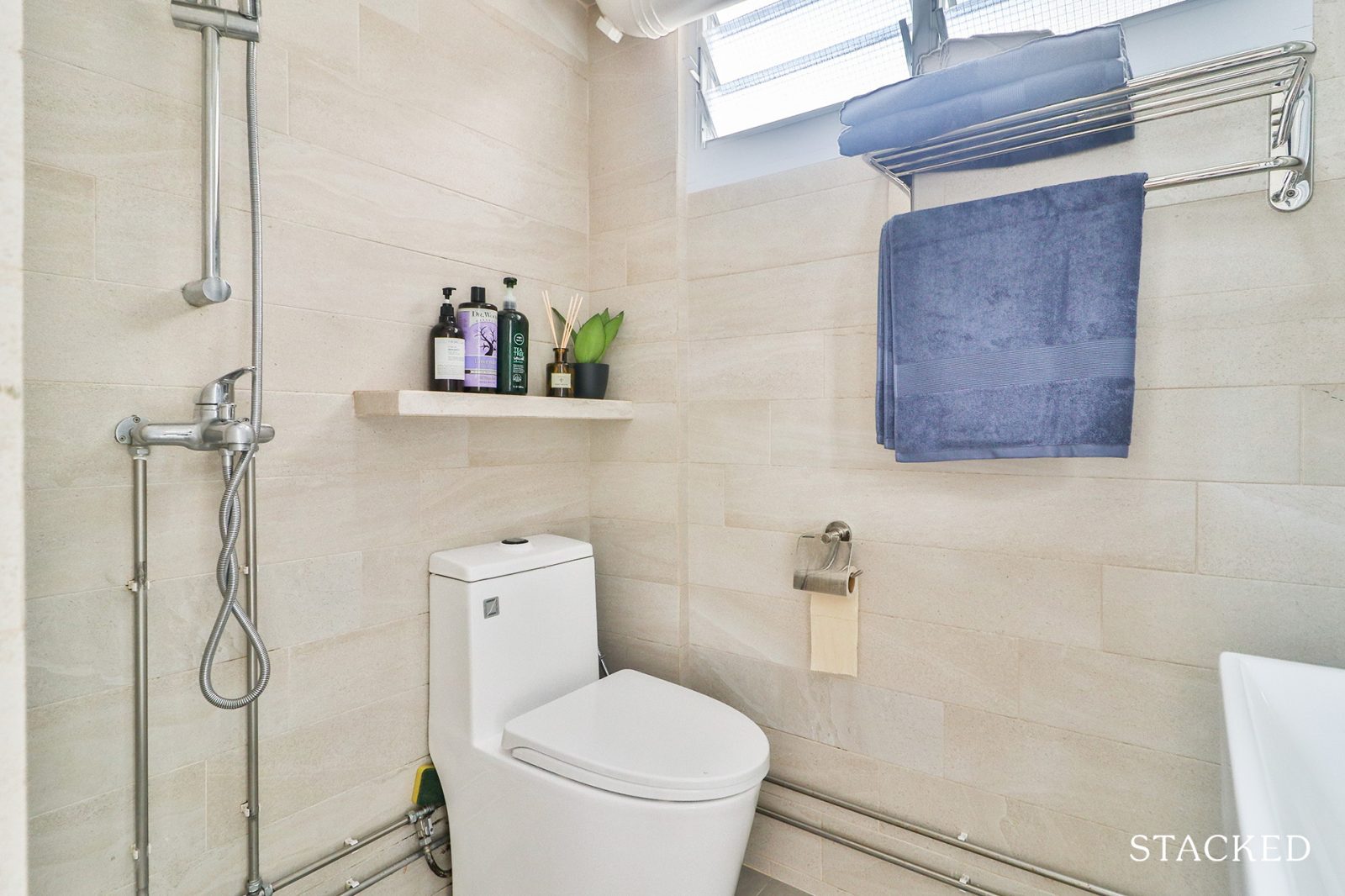
It’s the same story for the bathroom, another commonly overlooked space.
Many people usually have a variety of different coloured shampoo/soap bottles, which can look very messy.
I like to just introduce a few minimalist bottles (Aesop is a favourite, but is pricey), and instead of leaving the racks bare – a fluffy towel set will do wonders to the space.
For me, I like to go with a coloured set, as it does bring more vibrancy especially if the bathroom can look quite cold without staging it.
Another possible, inexpensive addition is lights – an example would be track lighting, which you can set up at the foot of a feature wall or other highlight area. These lighting tricks are why the designer homes in magazines look so good.
6. Highlight available storage
Storage is at a premium in our small Singapore homes; and cabinetry (read: carpentry) is one of the most expensive parts of the renovation.
Sometimes the storage spaces are a bit too cleverly hidden, like inside feature walls, or behind sliding panels. You may want to partially open these, so viewers notice they’re there.
As always, clean and declutter them – if you leave things in them, make them items that show off the available space (e.g., a few select golf clubs, to show that a hidden recess is big enough to hold such items).
Staging your home is a small investment of time and effort, for the potential returns it brings. If you’re struggling to do this, you can reach out to us below. In the meantime, you can also check out our reviews of new and resale condos alike.
If you’d like to get in touch for a more in-depth consultation, you can do so here.
Have a real estate question, or not sure what your options are? Email us at stories@stackedhomes.com.
Daron Ang
Daron is a multi-award-winning property consultant known for his dedication to service and unwavering passion for real estate. Embracing the ethos of giving back, he approaches each client interaction as a trusted friend and attentive listener, ensuring a personalised and seamless experience. To date, he has assisted over 400 clients with their real estate transactions. With a background in creating efficient structures and a commitment to continuous improvement, Daron consistently delivers optimal results for his clients, reflected in his impressive track record of success. In his free time, he dedicates himself to serving his church community at Kingdomcity, further exemplifying his commitment to making a positive impact both professionally and personally.Read next from Editor's Pick

Property Market Commentary 2025 Year-End Review Of The Singapore Property Market: What The Numbers Reveal

Property Market Commentary How The HDB Resale Market Performed In 2025, And What It Means For 2026 Prices

Property Market Commentary 4 Key Trends Reshaping Singapore’s New Launch Condo Market In 2026

Homeowner Stories What I Only Learned After My First Year Of Homeownership In Singapore
Latest Posts

Singapore Property News This HDB Just Crossed $1.3M For The First Time — In An Unexpected Area

Singapore Property News “I Never Thought I’d Be Sued by a Tenant.” What Long-Time Landlords in Singapore Miss

Property Market Commentary I Lived In Bayshore When It Was ‘Ulu’. Here’s How Much It Has Changed

Singapore Property News HDB Resale Prices Finally Slowed in 2025 — Will It Continue in 2026?

Singapore Property News Breaking News: District 23 Condo Sells Out In Under Two Years At $2,120 Psf Average

On The Market Here Are The Cheapest 3-Bedroom Condos in Central Singapore You Can Still Buy From $1.15M

Property Market Commentary Why The Singapore Property Market Will Be Different In 2026 — And It’s Not Just About Prices

Pro This 21-Year-Old Condo Didn’t Sell Out Initially, Yet Became A Top Performer

Singapore Property News Why More Land Doesn’t Automatically Fix Housing In Singapore

On The Market Here Are The Cheapest 4-Room HDB Flats in Central Singapore You Can Still Buy From $490K

Pro How A Once “Ulu” Condo Launched In 1997 Became A Top Performer

Property Market Commentary When Renting In Singapore Is The Smarter Move — And Buying Can Wait

Singapore Property News Lentor’s First Condo Is Complete — The Early Profits May Surprise You

On The Market These Are Some Of The Cheapest 5-Room HDB Flats Left In Central Singapore

Pro This 698-Unit Ang Mo Kio Condo Launched At The Wrong Time — And Still Outperformed Peers


